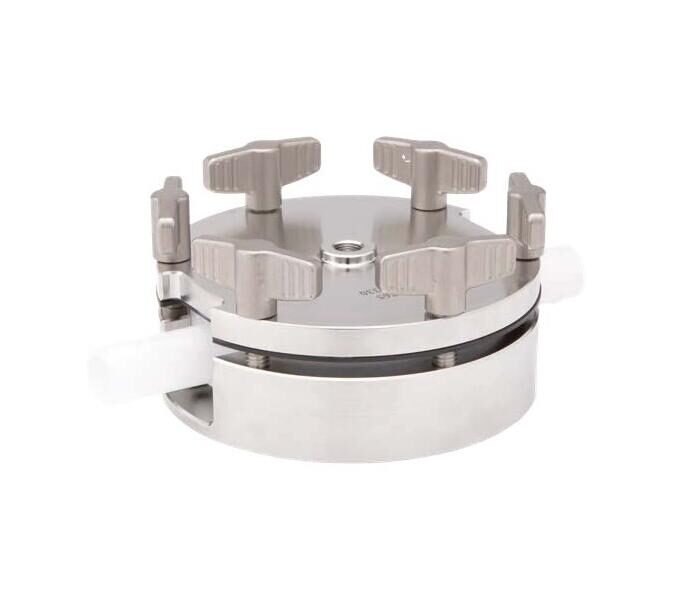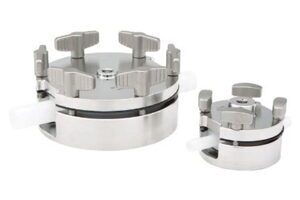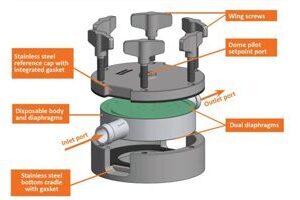Equilibar® Single Use Precision Back Pressure Regulator and Control Valves; SD-Series


- TFF for Perfusion or Downstream filtration
- Buffer dilution
- Chromatography – Upstream of Column
- Chromatography –Downstream of Column
- Filling Applications
- Blanketing, Gas Overlay Vent Valve
- Pulsation Dampening in Sanitary Process Systems


½”, ¾”, 1”, 1.5”, 2”, 3”


Hose Barb


SDO1 model (1/8”): 1E-4 – 0.06
SDO2 model (1/4”): 1E-4 – 0.4
SDO3 model (3/8”): 1E-4 – 0.9
SDO4 model (1/2”): 1E-3 – 1.6
SDO6 model (1/2”): 1E-3 – 4.0
SDO8 model (1/2”): 1E-3 – 7.0


4 barg (60 psig) standard, other available on request.


Depending on the pilot valve range


HDPE - USP Class VI, BPE and TSE free


HDPE - USP Class VI, BPE and TSE free




N/A (Equilibar valves does not have seat)


Pressure control
The Equilibar single use valve is a very precise alternative to a pinch valve. Its award-winning design allows it to be configured for precision pressure regulation or flow control.
Its strengths are particularly well suited to control the transmembrane pressure in tangential flow filtration or crossflow filtration, and dP control in virus filtration systems. The video demonstrates the stability and precision control of the Equilibar single use back pressure regulator.
Flow control
In addition to pressure control applications, the Equilibar SD can be used in on/off and flow control applications in single use processes. Potential advantages for on/off applications include the simple construction, ease of computer automation and low pressure drop. The Equilibar SD Single Use valve can control flow across a wider range of flow than other designs and is extremely responsive. Buffer delivery systems in gradient elution applications can benefit from using the Equilibar SD valve to control flow for precision blending.




Traditional back pressure regulators set the upstream pressure with a spring. These designs utilize sliding seals and other moving parts that can introduce hysteresis and other undesired effects into a process. The Equilibar® back pressure regulator uses a thin, supple diaphragm as the only moving part. This allows frictionless operation without cracking pressure or hysteresis. The accuracy of the Equilibar® back pressure regulator is determined by the accuracy of the pilot setpoint.
Description
Sanitary back
pressure valves are specifically designed for applications requiring hygienic
processing, such as those in biopharmaceutical and personal care products,
wherever is needed to maintain a constant upstream pressure.
The Equilibar® dome loaded multi-orifice valve technology is now available in a single use valve. The patent pending Equilibar® SD series single use valves are manufactured using USP Class VI polymers and stainless steel. The disposable valve body made of polymer is inserted into a stainless-steel support housing with wing nut closure for quick and easy assembly. The Equilibar single use valve for bioprocessing systems is a revolutionary design in single use pressure control.
The SD regulator features Equilibar’s patented dome-loaded multiple orifice technology delivering instantaneous control, frictionless operation, and superior precision across exceptionally wide flow rate ranges. The stainless-steel housing is designed as a permanent part of the process and connects to a dome pilot pressure supply. The disposable body is sold in a pre-sterilized state and comes ready for sterilization up to 50 kGy.
Once assembled, simply apply a pressure to the pilot port in the dome of the Equilibar valve equal to the desired setpoint and the valve does the rest. This pilot pressure forces the upper flexible diaphragm down onto a field of orifices. A rise in inlet pressure lifts the diaphragm up to allow excess pressure to be relieved through the outlet orifices. Similarly, a loss of pressure at the inlet causes the diaphragm to be pushed closer to the orifices, restricting flow and rebuilding pressure at the inlet.



